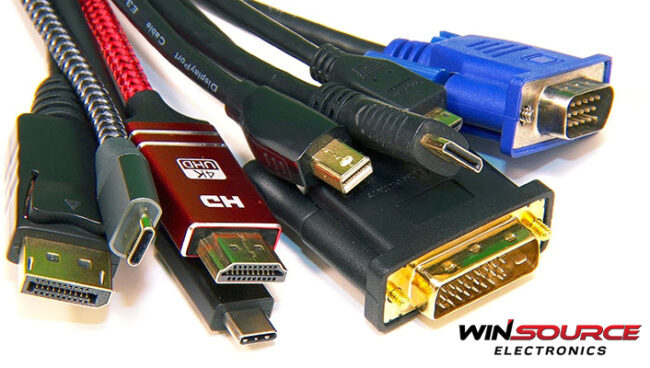
Display connectors are the key interface between connecting computers and display devices, and they play a vital role in signal transmission and compatibility. With the advancement of technology and constantly updated display standards, various types of display connectors have emerged. This article will deeply analyze several common display connector types, and compare their characteristics, advantages and disadvantages, and applicable scenarios, so as to help readers better understand and choose the appropriate display connector.
Table of Contents
ToggleHDMI (High Definition Multimedia Interface)
HDMI (High-Definition Multimedia Interface) is a common digital video and audio connector widely used in equipment such as high-definition televisions, computer monitors, and home theaters. The HDMI connector supports high-definition video transmission and multi-channel audio output, has the advantage of digital signal transmission, and can achieve high-quality audio-visual experience. Common versions of HDMI connectors include HDMI 1.4, HDMI 2.0, and HDMI 2.1, each with different features and bandwidth support.
The advantages of the HDMI connector are easy plugging and unplugging, high definition and support for audio transmission. It can provide high-quality video and audio transmission, supports 4K resolution, HDR (high dynamic range) and multi-channel audio formats, bringing users a richer audio-visual experience. The wide range of applications for HDMI connectors includes consumer electronic devices such as TVs, monitors, home theaters, and game consoles.
DisplayPort (display port)
DisplayPort is a digital display interface standard for connecting computers, monitors and other multimedia devices. DisplayPort connectors support high-definition video and audio transmission and feature high bandwidth and flexibility. It can transmit high-resolution video, multi-channel audio and other data, such as USB and Ethernet, etc.
There are several versions of DisplayPort connectors, including DisplayPort 1.2, DisplayPort 1.3, and DisplayPort 1.4, each with different bandwidth and feature support. The latest DisplayPort 2.0 standard offers higher bandwidth and more features for high-resolution displays and multi-monitor configurations.
One of the advantages of the DisplayPort connector is high bandwidth support and flexible configuration options. It is capable of transmitting high-resolution video, supports multi-display cascading and multi-stream transmission, and provides users with a richer display experience. DisplayPort connectors are widely used in professional fields and high-performance computing fields, such as graphic design, game development, and scientific computing.
VGA (Video Graphics Array)
VGA (Video Graphics Array) is an analog video connector commonly used in early computers and monitors. It transmits red, green and blue color signals and synchronous signals through 15 pins to realize image display. The most common interface of the VGA connector is the D-Sub 15-pin connector, which has limited ability to transmit analog video signals and limited resolution.
Although the VGA connector is outdated, it is still widely used in some specific scenarios, such as old computers, projectors and some industrial equipment. Also, due to the wide compatibility of the VGA connector, it can be compatible with various display devices and adapters, making it still a useful connection option in some situations.
However, VGA connectors also have some disadvantages. First, because it is an analog connector, its image quality and stability are worse than digital connectors. Analog signals are susceptible to interference and attenuation, resulting in reduced image quality. Secondly, the VGA connector does not support high resolution and high refresh rate, and cannot meet the needs of modern high-definition displays. Also, the VGA connector does not support audio transmission and requires an additional audio connection.
DVI (Digital Visual Interface)
DVI (Digital Visual Interface) is a digital video interface used to connect computers and digital displays. It supports high-resolution video transmission and was the dominant display connection standard during the interim. There are several types of DVI connectors, including DVI-D, DVI-I, and DVI-A. Among them, DVI-D only transmits digital signals, DVI-I transmits digital and analog signals, and DVI-A transmits only analog signals.
The main advantage of the DVI connector is its high resolution support and wide compatibility. It is suitable for display requirements that require high-quality images and higher resolution, such as professional graphic design, audio-visual editing, and games. However, the DVI connector does not support audio transmission, so an additional audio connection is required.
With the advent of new generations of monitors and graphics cards, DVI connectors are gradually being replaced by digital connectors such as HDMI and DisplayPort. These digital connectors support higher resolutions, more features, and audio transmission for better display experience and user convenience.
Thunderbolt (Thunderbolt interface)
Thunderbolt is a high-speed data transmission interface jointly developed by Apple and Intel. It combines PCI Express and DisplayPort technology to support high-speed data transmission, high-resolution video and audio transmission. The Thunderbolt connector usually uses the USB Type-C interface, so it has good compatibility and expandability. It is suitable for applications requiring high-speed data transmission and high-resolution display, such as professional video editing, audio production and data storage.
The advantage of the Thunderbolt connector is its great performance and versatility. It can achieve data transfer speeds of up to 40 Gbps, supports 4K and even 8K resolution video output, and multi-channel audio transmission. Additionally, the Thunderbolt connector also supports Daisy Chaining (connected in series) and powering external devices, making it ideal for connecting multiple external devices.
When selecting a monitor connector, there are trade-offs based on specific needs and device compatibility. HDMI and DisplayPort are modern digital display interfaces with the advantages of high definition and versatility, suitable for most consumer electronic devices. VGA and DVI connectors are still useful in certain scenarios, but have gradually been replaced by digital connectors. The Thunderbolt connector is a high-speed data and video transmission interface for professional and high-performance applications.
To sum up, different types of display connectors have their own characteristics and applicable scenarios. According to actual needs and device compatibility, choose the appropriate display connector type to obtain the best display effect and performance experience. As technology continues to advance, display connectors will continue to develop and evolve, providing users with more choices and a better experience.

COMMENTS